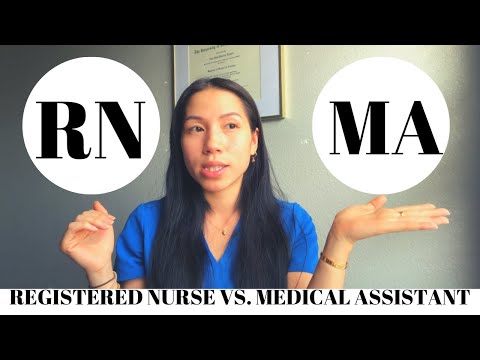What’s the Difference Between a Nurse and a Medical Assistant?
Contents
- The Difference between a Nurse and a Medical Assistant
- The responsibilities of a Nurse
- The responsibilities of a Medical Assistant
- The training and education required for a Nurse
- The training and education required for a Medical Assistant
- The job outlook for Nurses
- The job outlook for Medical Assistants
- The salary of a Nurse
- The salary of a Medical Assistant
- Why choose a career as a Nurse?
If you’re considering a career in healthcare, you may be wondering what the difference is between a nurse and a medical assistant Both roles are important in providing care to patients, but there are some key differences between the two. Here’s a look at the main differences between nurses and Medical assistants
Checkout this video:
The Difference between a Nurse and a Medical Assistant
Medical assistants and nurses perform many of the same duties in doctors’ offices, clinics, hospitals, and other healthcare facilities. Both occupations require an understanding of Medical Terminology and procedures, as well as excellent communication and people skills. However, there are some important differences between the two occupations. Nurses are licensed health care professionals who provide direct patient care, whereas Medical Assistants perform both clinical and administrative tasks. Nurses typically have more education and training than medical assistants, and they earn higher salaries.
The responsibilities of a Nurse
Nurses are responsible for the care of patients in hospitals and other health care settings. They work closely with doctors and other health care professionals to provide high-quality care. Nurses also play a vital role in patient education and preventative care.
The responsibilities of a Medical Assistant
Most medical assistants have postsecondary education such as a certificate. Postsecondary education programs usually last from 1 to 2 years and lead to a diploma, certificate, or an associate degree. Some states have approved certification programs that lead to certification in medical assisting. Employers prefer to hire candidates who have completed a formal training program in medical assisting.
Medical assistants perform many duties, including taking and recording patients’ vital signs and medical histories, explaining treatment procedures to patients, scheduling appointments, collecting and preparing laboratory specimens, performing basic laboratory tests, sterilizing medical instruments, and administering medications as directed by a physician.
The training and education required for a Nurse
Nurses have more training and education than medical assistants. To become a nurse, you must have a minimum of an Associate Degree in Nursing (ADN), although many nurses now have BSNs. You must also pass the NCLEX exam to become licensed. Nurses also have to complete continuing education credits to maintain their licenses.
The training and education required for a Medical Assistant
Medical assistants are trained and educated to perform both clinical and administrative tasks in a medical office. In contrast, nurses are educated to provide direct patient care. Although both occupations are in high demand, their duties, responsibilities, and required training and education differ.
Medical assistants usually have an Associate’s Degree or certificate from an accredited medical assistant program. The curriculum for these programs include instruction in medical terminology, physiology, anatomy, andadministrative office procedures. Most programs also include a clinical externship that gives students the opportunity to apply their knowledge and skills in a real-world setting.
Nurses must have at least an Associate’s Degree in Nursing (ADN), although many nurses opt to further their education by earning a Bachelor of Science in Nursing (BSN). The curriculum for nursing programs includes coursework in anatomy, physiology, microbiology, as well as general education requirements. In addition to their academic coursework, nursing students also participate in clinical rotations that provide them with hands-on experience caring for patients.
The job outlook for Nurses
Nurses have one of the most important jobs in the medical field. They are responsible for the care and well-being of patients. Medical assistants, on the other hand, are responsible for assisting doctors and nurses with patient care.
The job outlook for nurses is good. The Bureau of Labor Statistics projects that employment of registered nurses will grow by 15 percent from 2016 to 2026. This is much faster than the average for all occupations. The demand for nurses is driven by the need for healthcare services, as the Baby Boomer population ages and people live longer.
The job outlook for Medical Assistants
The job outlook for medical assistants is promising. According to the U.S. Bureau of Labor Statistics, employment of medical assistants is expected to grow 19 percent from 2019 to 2029, much faster than the average for all occupations. With an aging population and advances in medical technology, there will be an increasing need for health care services. As a result, demand for medical assistants will grow as well.
The salary of a Nurse
The salary of a Nurse is higher than that of a Medical Assistant. Nurses have more responsibility than Medical Assistants, and they also usually have more training. Nurses can advance their careers by becoming nurse practitioners or going into management.
The salary of a Medical Assistant
Medical Assistants (MAs) are healthcare professionals who provide clinical and administrative assistance to physicians, nurses, and other health care providers. MAs perform a variety of tasks, including taking medical histories and recording vital signs, preparing patients for examination, assisting during medical procedures, sterilizing equipment, and instructing patients about medication and diet. They also may perform basic laboratory tests, dispose of contaminated supplies, arrange diagnostic testing, and handle correspondence. Although their duties vary by state law and by the type of facility in which they work, MAs typically do not require certification or licensure.
In addition to performing routine administrative tasks, MAs often are responsible for scheduling appointments, handling finances, ordering supplies, and maintaining medical records They also may educate patients about health maintenance and disease prevention. MAs typically report to an administrator or a physician.
Why choose a career as a Nurse?
Nurses play a vital role in the healthcare industry. They provide care and support to patients of all ages, from newborns to the elderly. Nurses work in a variety of settings, including hospitals, clinics, long-term care facilities, and private homes.
Medical assistants are another important part of the healthcare industry. They provide administrative and clinical support to physicians and other medical professionals. Medical assistants work in a variety of settings, including hospitals, clinics, physician’s offices, and insurance companies.
So, what’s the difference between a nurse and a medical assistant? Nursing is a more hands-on position that involves direct patient care. Medical assistants are more involved in the administrative side of healthcare. Both positions are important and necessary for the smooth functioning of the healthcare industry.







